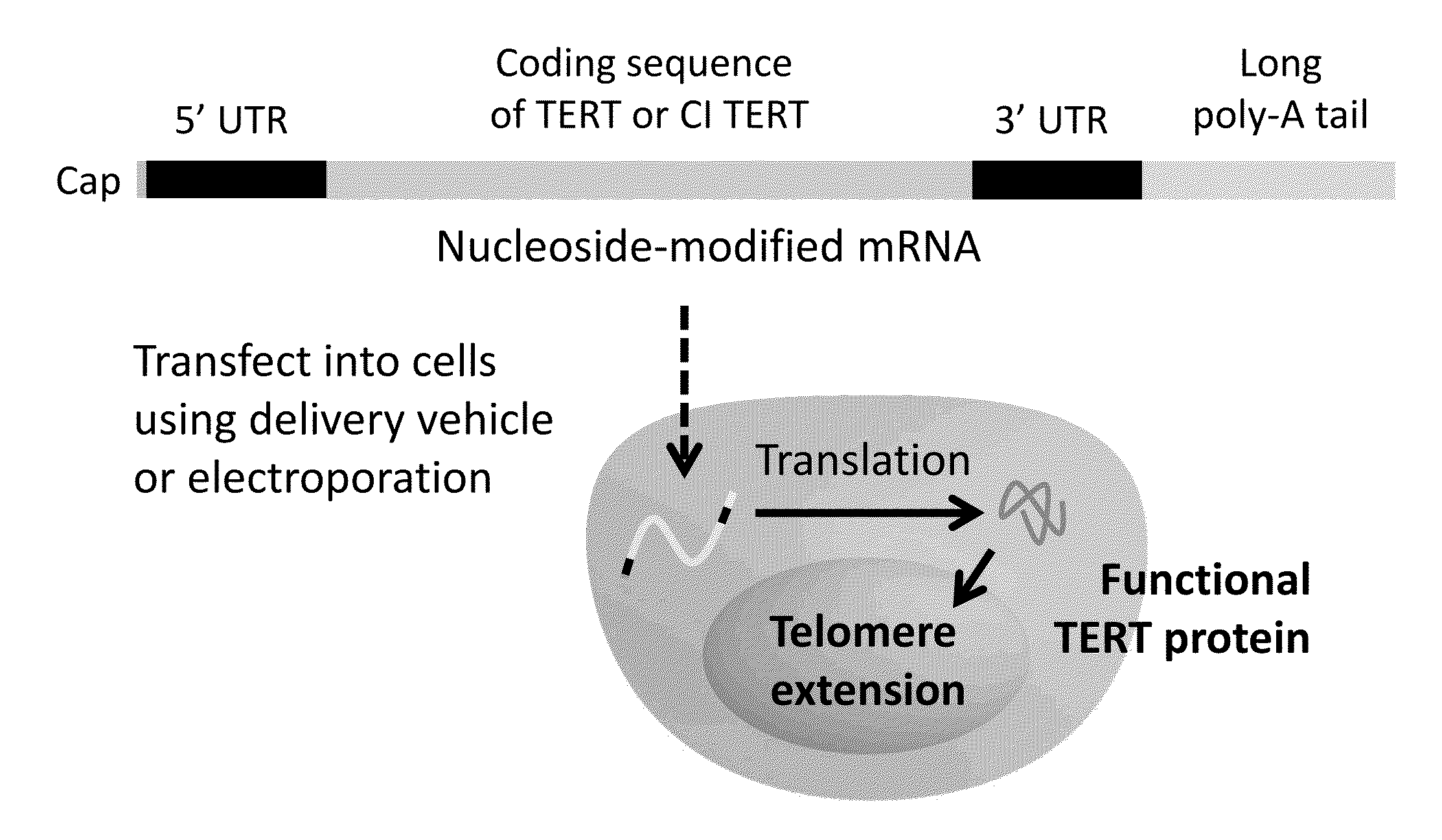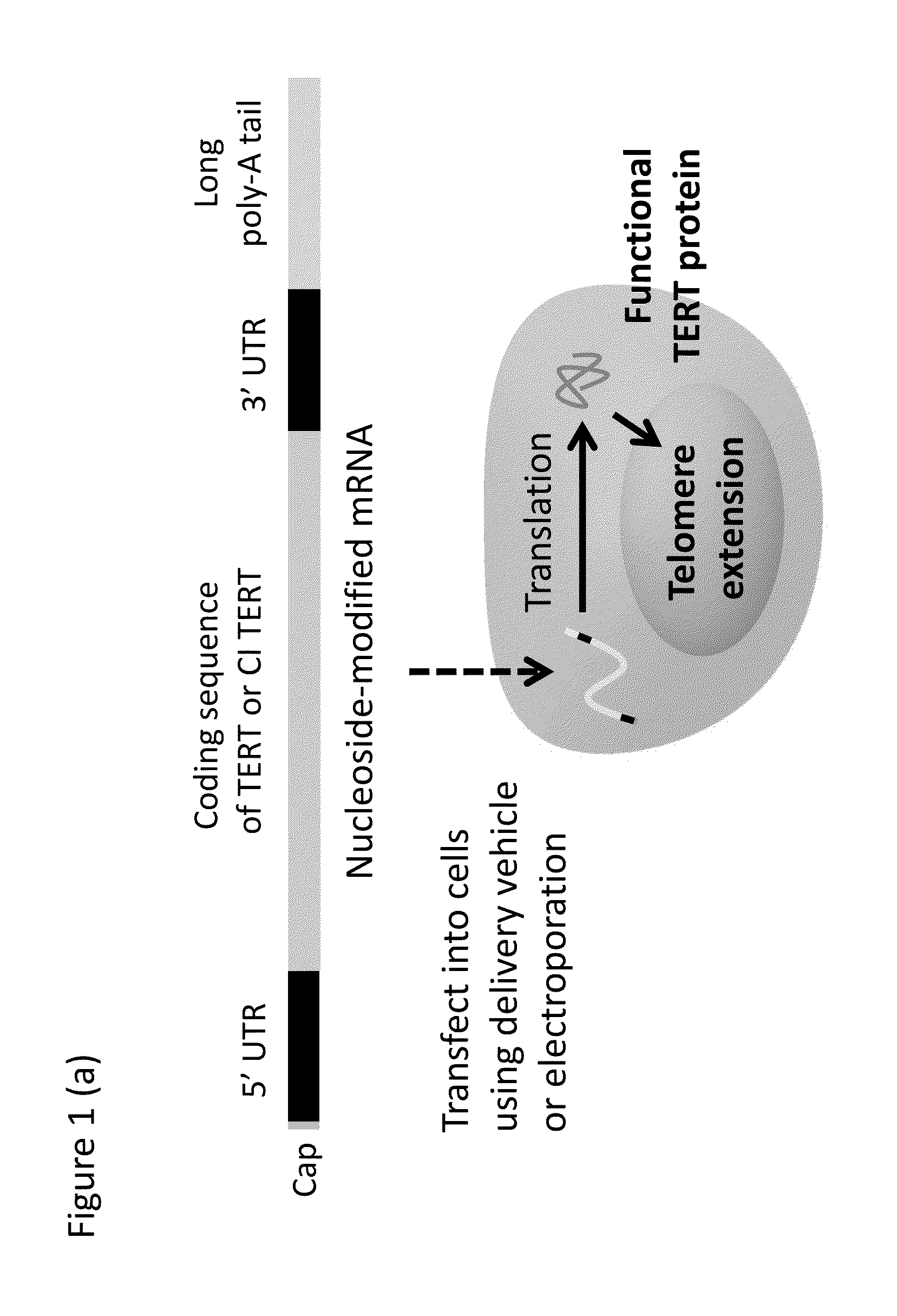Compounds, Compositions, Methods, and Kits Relating to Telomere Extension
a technology of telomeres and kits, applied in the field of compounds, compositions, methods, kits relating to telomere extension, can solve the problems of critical short telomeres that cannot form protective loops, increase cancer risk, shorten telomeres, etc., and achieve no risk of genomic insertional mutagenesis, high transient increase in telomerase activity
- Summary
- Abstract
- Description
- Claims
- Application Information
AI Technical Summary
Benefits of technology
Problems solved by technology
Method used
Image
Examples
example 1
Highly Efficient Telomere Extension in Human Cells Using Modified mRNA Encoding Telomerase
[0148]Diseases of inadequate telomere length maintenance and the need for increased cell replicative capacity for cell therapies and bioengineering applications motivate development of safe methods for telomere extension. Blackburn et al. (2010) Cancer Prev Res (Phila) 3:394-402; Calado et al. (2012) Leukemia 26:700-707; Alter et al. (2009) Blood 113:6549-6557; Mohsin et al. (2012) Journal of the American College of Cardiology doi:10.1016 / j.jacc.2012.04.047. mRNA delivery to transiently increase the amount of protein encoded by the mRNA for therapeutic applications is facilitated by incorporation of modified nucleosides reduce immunogenicity and increase stability. Karikó et al. (2005) Immunity 23:165-175; Karikó et al. (2011) Nucleic Acids Res. 39:e142; doi: 10.1093 / nar / gkr695.
[0149]To be therapeutically useful, a telomere extension treatment should ideally be non-immunogenic; specific; capabl...
example 2
Effects of TERT modRNA Treatment on Human Endothelial Cells
[0191]The effects of TERT modRNA treatment is not limited to fibroblast cells. As shown in FIG. 9, human microvascular dermal endothelial cells (“HMDEC”) display typical doubling curves, with early onset of senescence at approximately passage #12 and with cells completely senescent at passage #17. As shown in FIG. 10, treatment of these cells at passage #18 with wild-type hTERT modRNA (right bar in each series) results in the reversal of senescence, whereas control treatment (left bar in each series), or treatment with mutant hTERT modRNA (middle bar in each series), had no effect on cellular senescence.
[0192]FIG. 11 demonstrates the effects of various treatments on the growth of HMDECs. Specifically, cells treated three times with wild-type TERT modRNA (WT) between passage #10 and passage #11 continued to grow, whereas untreated cells (UT), cells treated with carrier only (CO), and cells treated with a catalytically-inactiv...
example 3
Further Characterization of the Effects of TERT modRNA Treatment on Human Cells
[0198]In this example, the mRNA was transfected via a cationic lipid into primary human fibroblasts and myoblasts (FIG. 13A), cells known to have limited proliferative capacity. Webster and Blau (1990) Somat Cell Mol Genet. 16:557-565; Hayflick and Moorhead (1961) Exp Cell Res. 25:585-621; Yakubov et al. (2010) Biochem Biophys Res Commun. 394:189-193. Transfection efficiency was determined using flow cytometric single cell quantitation of fluorescence following delivery of GFP mRNA, which showed that most cells (>90%) were transfected even at relatively low concentrations of modified mRNA (0.1 μg / ml) (FIG. 13B and FIG. 16A-C). Treatment of cells with equal concentrations of exogenous TERT mRNA or mRNA encoding a catalytically inactive (CI) form of TERT resulted in internalization of similar amounts of mRNA (FIG. 16D), as measured by RT-qPCR 24 h after the first treatment. CI TERT has a substitution mutati...
PUM
| Property | Measurement | Unit |
|---|---|---|
| Fraction | aaaaa | aaaaa |
| Fraction | aaaaa | aaaaa |
| Time | aaaaa | aaaaa |
Abstract
Description
Claims
Application Information
 Login to View More
Login to View More - R&D
- Intellectual Property
- Life Sciences
- Materials
- Tech Scout
- Unparalleled Data Quality
- Higher Quality Content
- 60% Fewer Hallucinations
Browse by: Latest US Patents, China's latest patents, Technical Efficacy Thesaurus, Application Domain, Technology Topic, Popular Technical Reports.
© 2025 PatSnap. All rights reserved.Legal|Privacy policy|Modern Slavery Act Transparency Statement|Sitemap|About US| Contact US: help@patsnap.com



